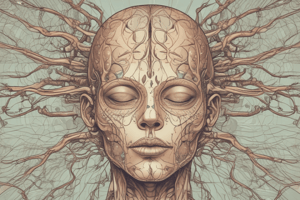Podcast
Questions and Answers
The optic nerve is responsible for the sense of smell.
The optic nerve is responsible for the sense of smell.
False (B)
The facial nerve is associated with facial expressions and taste.
The facial nerve is associated with facial expressions and taste.
True (A)
Cranial nerves are only involved in motor functions.
Cranial nerves are only involved in motor functions.
False (B)
The olfactory nerve carries information from the nasal cavity to the brain.
The olfactory nerve carries information from the nasal cavity to the brain.
Ganglia are groups of nerve cells that relay information within the spinal cord only.
Ganglia are groups of nerve cells that relay information within the spinal cord only.
The vagus nerve has a wide range of functions within the body.
The vagus nerve has a wide range of functions within the body.
All cranial nerves are numbered from I to XI.
All cranial nerves are numbered from I to XI.
The accessory nerve controls muscles in the head and neck region.
The accessory nerve controls muscles in the head and neck region.
Nervul olfactiv (I) este responsabil pentru vederea.
Nervul olfactiv (I) este responsabil pentru vederea.
Nervul trigemen (V) are funcții legate de senzația facială și masticație.
Nervul trigemen (V) are funcții legate de senzația facială și masticație.
Nervul abducens (VI) este asociat cu mișcarea ochilor.
Nervul abducens (VI) este asociat cu mișcarea ochilor.
Nervul hipoglosal (XII) este responsabil pentru mișcarea limbii.
Nervul hipoglosal (XII) este responsabil pentru mișcarea limbii.
Cranial nerves are labeled from I to XII.
Cranial nerves are labeled from I to XII.
Nervul vestibulocohlear (VIII) are funcții legate de auz și echilibru.
Nervul vestibulocohlear (VIII) are funcții legate de auz și echilibru.
Nuclei nervoși sunt grupuri de celule nervoase responsabile doar pentru funcții motorii.
Nuclei nervoși sunt grupuri de celule nervoase responsabile doar pentru funcții motorii.
Nervul vag (X) are funcții limitate în corp.
Nervul vag (X) are funcții limitate în corp.
Flashcards
Cranial Nerve I
Cranial Nerve I
The olfactory nerve; responsible for smell.
Cranial Nerve II
Cranial Nerve II
The optic nerve; responsible for vision.
Cranial Nerve III
Cranial Nerve III
Oculomotor nerve; controls eye movement.
Cranial Nerve V (Trigeminal)
Cranial Nerve V (Trigeminal)
Signup and view all the flashcards
Cranial Nerve VII (Facial)
Cranial Nerve VII (Facial)
Signup and view all the flashcards
Cranial Nerve VIII
Cranial Nerve VIII
Signup and view all the flashcards
Cranial Nerve X
Cranial Nerve X
Signup and view all the flashcards
Cranial Nerves
Cranial Nerves
Signup and view all the flashcards
Nervii Cranieni
Nervii Cranieni
Signup and view all the flashcards
Funcții senzoriale
Funcții senzoriale
Signup and view all the flashcards
Funcții motorii
Funcții motorii
Signup and view all the flashcards
Nervul Olfactiv (I)
Nervul Olfactiv (I)
Signup and view all the flashcards
Nervul Optic (II)
Nervul Optic (II)
Signup and view all the flashcards
Nervul Trigemen (V)
Nervul Trigemen (V)
Signup and view all the flashcards
Nervul Facial (VII)
Nervul Facial (VII)
Signup and view all the flashcards
Nervul Vestibulocohlear (VIII)
Nervul Vestibulocohlear (VIII)
Signup and view all the flashcards
Study Notes
Cranial Nerves
- Cranial nerves are part of the peripheral nervous system, carrying signals between the brain and the body.
- There are 12 pairs of cranial nerves.
- Each nerve has a specific function and carries different types of information.
Cranial Nerve Functions
- Olfactory (I): Sensory, smell
- Optic (II): Sensory, vision
- Oculomotor (III): Motor, eye movement (most extrinsic eye muscles), pupil constriction
- Trochlear (IV): Motor, eye movement (superior oblique muscle)
- Trigeminal (V): Mixed, sensory from face (touch, pain, temperature), motor to chewing muscles
- Abducens (VI): Motor, eye movement (lateral rectus muscle)
- Facial (VII): Mixed, sensory from taste buds on anterior 2/3 of tongue, motor to facial muscles, salivary glands
- Vestibulocochlear (VIII): Sensory, hearing and balance
- Glossopharyngeal (IX): Mixed, sensory from taste buds on posterior 1/3 of tongue, motor to pharyngeal muscles, salivary glands
- Vagus (X): Mixed, sensory from visceral organs, motor to visceral organs, parasympathetic innervation
- Accessory (XI): Motor to shoulder and neck muscles
- Hypoglossal (XII): Motor, tongue muscles
Additional Notes
- Some nerves are purely sensory (carrying only input information).
- Others are purely motor (carrying only output information).
- Many cranial nerves are mixed, carrying both sensory and motor information.
Studying That Suits You
Use AI to generate personalized quizzes and flashcards to suit your learning preferences.




